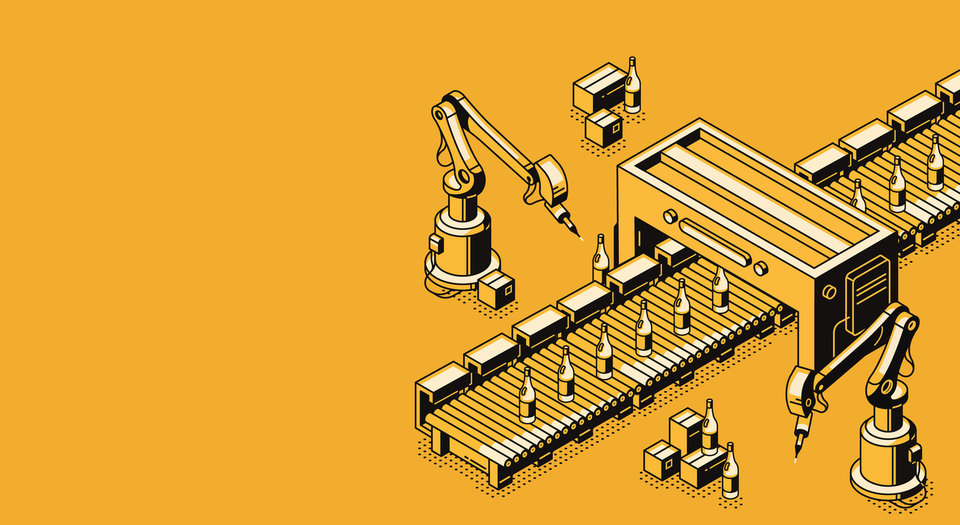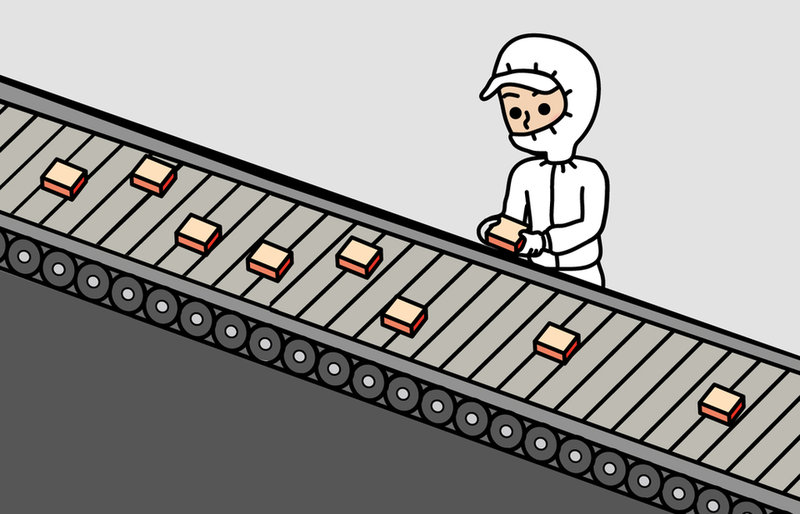
manufacturing | processing
Producing the goods: Covid-19’s impact on food manufacturing
How could the virus shape, in the longer term, how food companies organise their manufacturing and the products they offer? Simon Creasey explores.
A
s industries have reacted to Covid-19, two of the big business buzzwords of 2020 have been ‘unprecedented’ and ‘accelerated’.
In the food sector, there have been unprecedented demands placed on retailers and manufacturers as lockdowns and restrictions on movement saw out-of-home consumption shift in-home.
Manufacturers relying on a strategy of just-in-time inventory found stocks coming under pressure and having to rapidly react. And manufacturers did, with a more stable picture of production emerging.
The last eight or nine months have also seen other changes to consumer purchasing habits that typically take years to filter through. The industry has seen an acceleration in the take-up of online grocery shopping, adding further demands on industry to reshape and manage distribution and manufacturing.
Lasting impact on safety
Within factories, food manufacturers, already well-versed in managing production to strict hygiene and safety standards, have spent millions of dollars on personal protective equipment and installing other equipment to manage social distancing.
That investment, however, hasn’t stopped food factories the world over from becoming hotspots for the virus, especially in sectors such as meat, where staff work closely to each other. Output at food manufacturers of various types of products, however, has been disrupted by labour shortages and shutdowns.
Some of the changes we’ve seen in 2020 will be short term. However, some are here to stay and will have a significant impact on food manufacturers over the coming years.
Almost all of the major food groups contacted for this article to talk about how the pandemic will impact the way they manufacture – and what they manufacture – in the future either declined to comment or failed to respond. One company said the topic was a bit too “extracurricular” at the moment.
The reluctance of food companies to speak about the changes that could occur over the next few years could be down to the fact they’re the ones that are going to be most affected. There may be some reticence to speak publicly due to the possible impacts on jobs.
There will be a re-prioritisation of health and safety standards in general, but in particular with regard to employee health
The reluctance of food companies to speak about the changes that could occur over the next few years could be down to the fact they’re the ones that are going to be most affected. There may be some reticence to speak publicly due to the possible impacts on jobs.
In the aftermath of the Covid-19, health and safety and worker well-being are expected to be key priorities for food manufacturers. Factories, where social distancing and other safety measures are more challenging to implement, have been breeding grounds for the virus, so manufacturers are exploring a range of solutions to try to ensure worker safety and keep production ticking over.
“The pandemic has made all food manufacturers reassess and implement new processes to ensure they remain operational and are protecting the health and safety of their workforce,” says Will Cooper, CEO and founder of UK-based Delfin Health, which has just launched an AI health data management tool called Klarity it says allows employers to monitor and test the health and safety of their workforce.
“We believe many of these new processes will remain in place post the pandemic and that there will be a re-prioritisation of health and safety standards in general, but in particular with regard to employee health,” Cooper adds.
Turning to automation
One way of ensuring worker safety in production environments is a greater reliance on automation – a trend emerging pre-pandemic that is anticipated to accelerate.
“We do see an increased demand for our automation solutions, and Covid-19 has accelerated this trend,” says Stuart Bashford, digital officer of networked technologies at Bühler, the Switzerland-based multinational making plant equipment. “Food manufacturers have been producing at capacity throughout most of the year, and our automation solutions are supporting them in ensuring food safety and making them more successful.”
Matthew Simpson, a sales manager in the UK and Ireland for CSB-System, a US-based business providing software to the food industry, also expects more food companies will embrace automation as they juggle the challenge of keeping workers safe at the same time as manufacture products.
“The motivation to automate processes is greater than ever,” says Simpson. “Automate a task and you increase productivity as well as making the rest of the workforce safer. The cold economics of cost, benefit and return are now tipping more often towards investment in automation and the digital systems, which join up the machines.”
However, there are major caveats to the automation push. For one, it’s difficult to automate some food manufacturing processes.
“The food businesses that face the biggest challenge when it comes to automation are those in the super-fresh segment,” Anna Overton, analytical manager at credit ratings giant S&P Global Ratings, says. “Production of salads and prepared meals, for example, demands a high level of human resource. Abattoirs are also very labour intensive, since butchering a large animal, such as a cow, is a complex and lengthy process.”
Simplified product lines
During the pandemic, many food manufacturers have produced fewer SKUs as their retail customers – battling that shift to at-home consumption and, at times in certain markets, pantry loading by consumers – demanded less complexity to focus on the best-sellers and to help keep shelves stocked.
The production of fewer SKUs can, of course, allow for longer production runs and therefore help support profitability and cash flow. Before the virus struck, some manufacturers had already been looking at the amount of SKUs they offer, as part of internal initiatives to focus resources on the best-performing products and bolster margins. There were external factors, too, with retailers’ range reviews and product rationalisation processes. Covid-19 accelerated all this.
“Retailers already looked at their ranges one to two years ago, and asked: ‘Do we need multiple versions of the same product? Can we reduce and simplify?’ I think the pandemic has amplified this thinking, simply because large and hugely efficient companies, such as Premier Foods, have prospered during lockdown, where others haven’t,” Overton says. “Now, supermarkets must work with their suppliers and consider how the entire set-up can be rationalised – for instance, whether they need so many stock-keeping units.”
While this autumn some food manufacturers have spoken about rebuilding their ranges in certain areas, uncertainty around the virus remains. Vaccine trials are offering promise, but Covid-19 remains a genuine danger and countries the world over are still in the midst of strict lockdowns, presenting continuing challenges for the food supply chain.
Supermarkets must work with their suppliers and consider how the entire set-up can be rationalised
Some industry watchers believe retailers will persist with a laser focus on manufacturers’ SKUs when the pandemic has passed.
“I think the retail dynamic is going to be different,” says Andy Searle, a managing director and partner at management consultants AlixPartners, reflecting on the UK grocery scene. “In the during-Covid-19/post-Covid-19 recession, lots of the retailers [in the UK] are positioning themselves to defend against Aldi and Lidl in a way that they didn't in 2008.”
“What that will result in, is a core few thousand SKUs at each supermarket and then a range around that – and that [those] core SKUs will be price-matched to the discounters under the value proposition. The bits around that will be more premium space. It will be more innovation, maybe health and wellness, and maybe some other areas.”
Investing in innovation
Before the virus struck, major food groups, faced with intensifying competition from smaller, more agile businesses, were also looking closely at how they develop and launch products to market. Many had sought to introduce ways of getting products to market more quickly. As Covid-19 spread across the world and the industry’s focus was on trying to keep staff safe and shelves stocked, innovation projects were paused.
A more streamlined product range should free up resources to invest in innovation and some food industry experts anticipate innovation accelerating again over the next few years.
“There's more of a need and there's more pressure on these big [food] firms to be more agile and to run quicker development cycles, and that's manifesting as there's more of an appetite to take risk,” says Hamish Renton, managing director at UK-based international food and drink consultancy HRA Global.
“We're likely to see more innovation. It will probably not be as polished as it has been in the past. Firms are less likely to keep polishing until they're absolutely certain they are going to succeed. They are more likely to punt it out and see what happens.”
Renton thinks a lot of innovation will focus around convenience thanks to changes to the way people work in the future as a result of the pandemic. “Even working from home, people just want to grab and go,” he says. “We will also see a continuation of [consumer] demand for health products. Health in all of its many forms continues to grow rapidly.”
We're likely to see more innovation. It will probably not be as polished as it has been in the past
However, Renton says that if – as he predicts – the industry is going to see the pace of innovation pick up, it may not always be possible if a business is over-reliant on automation.
“I think that agility is going to be prized in the future and most robots aren't very agile – the tolerances of what they can do is a lot less than a human,” says Renton. “I agree that, on the one hand, there's a drive towards gauging out variability and the human factor in production, but on the other hand, there's this drive towards agility and flexibility.
“The one thing humans give you is that ability to move around what they do from day-to-day. They don't need retooling. They can crack on with it. Automation will probably accelerate in standardised categories, but you don't want to start with a whole load of robots that are only able to really efficiently make a certain category of product that nobody wants any more.”

Nevertheless, it’s those standardised, middle-of-the-road brands the likes of Renton and Searle think are in the greatest danger of being cut as part of the continued focus on slimmed-down ranges.
As well as looking within existing facilities and how they are configured, supply-chain executives at the world’s packaged foods majors will be studying, too, whether to relocate parts of their production network closer to markets. It’s a point of debate, with some believing Covid-19 will accelerate a trend the industry was seeing of localisation and others unsure whether executives of major groups headquartered in developed markets would bring much production closer to home due to cost.
After the strains of the early weeks of the pandemic, food manufacturers ensured there was plenty of food to be bought. However, as we emerge into a post-pandemic world, manufacturers are going to have to adapt again to meet changing retailer and consumer demands, while considering whether to build some greater, underlying resilience into the system should there be future shocks.
It’s going to be a period of unprecedented change and an acceleration of trends, but it also presents significant opportunities for agile food manufacturers to capitalise on.